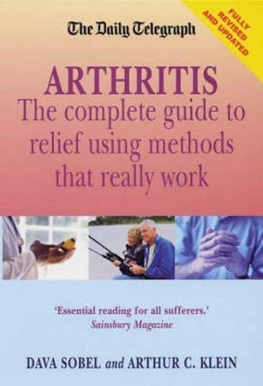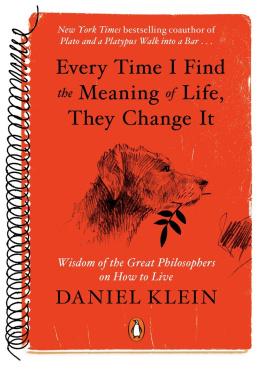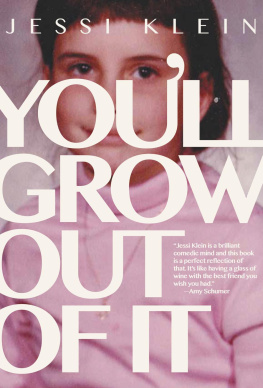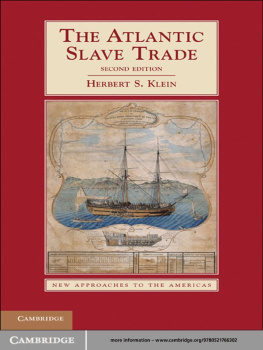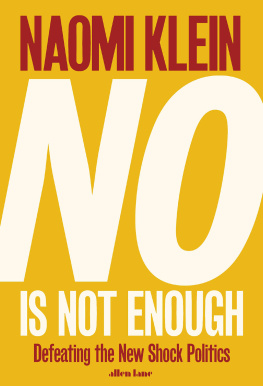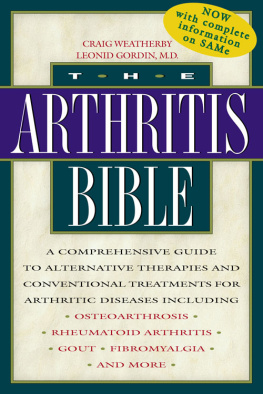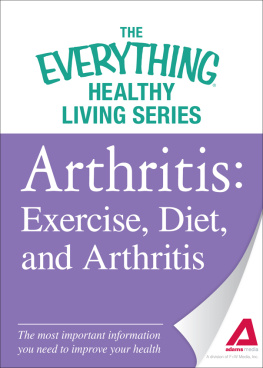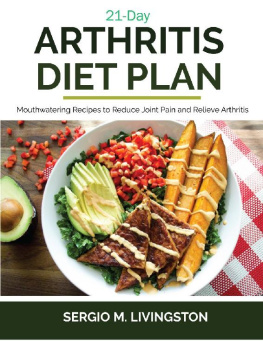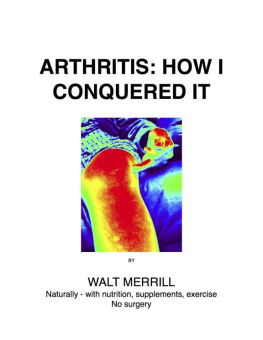About the Author
ARTHUR C. KLEIN is the author of Arthritis: What Really Works (Robinson, 1994), an evaluation of treatments that really help, based on an unprecedented and extensive survey of more than 1,000 people in the USA with osteo- or rheumatoid arthritis. The result was described in the Sunday Telegraph as a truly excellent book and sold nearly half a million copies in the USA alone. Kleins finding that exercise was the most powerful treatment for many forms of arthritis led to a follow-up book, Arthritis: What Exercises Really Work, which was published in the UK in 1996.
Note
This book is intended as a reference volume only, not a manual for self-treatment.
Every effort has been made to ensure the contents of this book are accurate and current. Medical and pharmaceutical knowledge is constantly changing and the application of it to particular circumstances depends on many factors. Therefore readers are urged always to consult a qualified medical specialist for individual advice. The writers, researchers and publishers of this book cannot be held liable for any errors or omissions, or action that may be taken as a consequence of using it.
Note from the author
Many of the 1,051 participants in the US nationwide Arthritis Survey performed the exercises in this book to good advantage. The program as a whole has been reviewed and approved by several US physicians who are considered experts on the topic of exercise. Nevertheless, your own physical condition may require special modifications and precautions. We encourage you to show this book to your doctor before beginning to practise this program.

Constable & Robinson Ltd
3 The Lanchesters
162 Fulham Palace Road
London W6 9ER
www.constablerobinson.com
This revised edition published in the UK by Robinson, an imprint of Constable & Robinson Ltd 2005
Copyright Arthur C. Klein 2005
The right of Arthur C. Klein to be identified as the author of this work has been asserted by him in accordance with the Copyright, Designs & Patents Act 1988.
A combined edition first published in the UK by Robinson Publishing Ltd 1998.
Arthritis: What Really Works first published in the UK by Robinson Publishing Ltd 1994; first published in the USA as Arthritis: What Works by St Martins Press 1989.
Arthritis: What Exercises Really Work first published in the UK by Robinson Publishing Ltd 1996; first published in the USA in 1993.
Arthritis: What Really Works copyright Dava Sobel & Arthur C. Klein 1989; Arthritis: What Exercises Really Work copyright
Dava Sobel & Arthur C. Klein 1993.
Illustrations by John Dickinson.
All rights reserved. This book is sold subject to the condition that it shall not, by way of trade or otherwise, be lent, re-sold, hired out or otherwise circulated in any form of binding or cover other than that in which it is published and without a similar condition including this condition being imposed on the subsequent purchaser.
A copy of the British Library Cataloguing in Publication data is available from the British Library
ISBN 1-84529-073-9
ISBN 978-1-84529-073-3
eISBN 978-1-47210-360-4
Printed and bound in the EU
3 5 7 9 10 8 6 4 2
Acknowledgments
Thanks to Regina Gload, most of all, and also to Bridget MacSweeney and Eva Collins, for handling all the clerical work involved in conducting the Arthritis Survey;
To Kathleen Pratt, M.S., R.D., for turning the dietary suggestions of survey participants and researchers into the Arthritis Survey Diet and Thirty-Day Meal Plan;
To Anthony F. Hitchcock and Jean Lindgren, for their help with the on-line searches of the medical literature;
To rheumatologists Barry L. Gruber, M.D., and Michael V. Sobel, M.D., for their expert opinions and advice;
To Willibald Nagler, M.D., and Irene von Estorff, M.D., of the Department of Rehabilitation Medicine at The New York Hospital-Cornell Medical Center, for their careful review of the exercise recommendations;
To Jared Kieling of St. Martins Press, for pursuing and endorsing this project; and
To the 1,051 Arthritis Survey participants, for sharing their knowledge and experiences.
Introduction
The treatment of arthritis can at times seem both complex and confusing. The range of remedies is certainly diverse, with orthodox doctors placing their trust in drugs and surgery while complementary practitioners tend to advocate more physical forms of therapy and dietary manipulation.
The great virtue of this book is that it makes sense of this confusion by allowing the real experts arthritis sufferers themselves to express their opinion on the relative merits of these two approaches.
The main reason for the multiplicity of different treatments is that, regrettably, no single cause for arthritis has been discovered. Genetic inheritance certainly plays a role in some variants such as osteoarthritis, and there is no doubt the main symptoms of pain and stiffness can become more severe with ageing. Yet the precise trigger that starts off the inflammation in the joints and there must be one has still to be identified. When the cause of arthritis is found as undoubtedly it will be at some point in the future then it might be possible to develop some new treatment that will stop the disease in its tracks. In the meantime, the only alternative for the individual is to find those treatments that suit them best by either palliating or minimizing their symptoms, or by slowing down the progress of the disease. But where to start?
The difference in approach between the mainstream and alternative therapies goes back to the 1950s when steroids and other anti-inflammatory drugs were found to have a dramatic effect in alleviating the symptoms of arthritis. Many doctors at the time thought these were the answer to combat arthritis, and became heavily committed to drugs as the only scientifically respectable mode of treatment, dismissing any other therapy. Regrettably, drugs and particularly steroids in the treatment of rheumatoid arthritis did not fulfil early expectations and their usefulness was soon found to be severely compromised by the serious side effects they caused.
The surge in popularity of complementary medicine, starting in the 1970s, led to the rediscovery of more traditional approaches to treatment that had been neglected by mainstream medicine, and nowhere was this more obvious that over the vexed issue of diet. In medical textbook terms arthritis was perceived as being the result of an aggressive attack by the bodys immune system, causing severe inflammation of the joints and for which the obvious cure was through drugs that depressed the result of the inflammatory response anti-inflammatory drugs. Doctors dismissed any suggestion that diet might be important because it was impossible to see how it might have fitted into this traditional mode of thought. Nonetheless many patients have since discovered that dietary changes such as cutting down on fatty foods or increasing the amount of fish consumed could on occasion be quite dramatically beneficial in easing their arthritis, and often much more so than the drugs they had been prescribed.
It is in this context where individual responses to any treatment whether mainstream or alternative is highly variable, that a dispassionate view is at a premium, and who better to provide it than the real experts: the patients themselves. The crucial message to emerge is that there is no right or wrong treatment in this matter but rather that people must test out remedies for themselves and should trust their own judgement.
Next page
